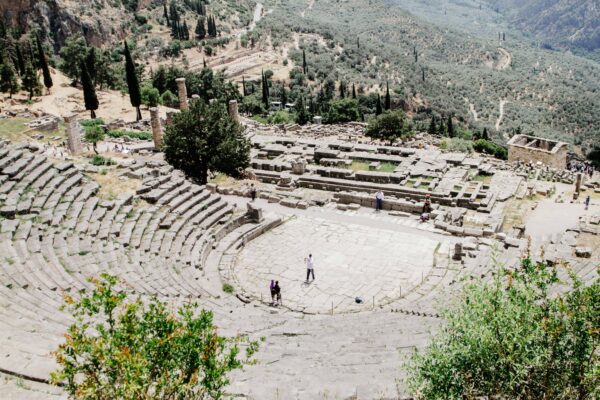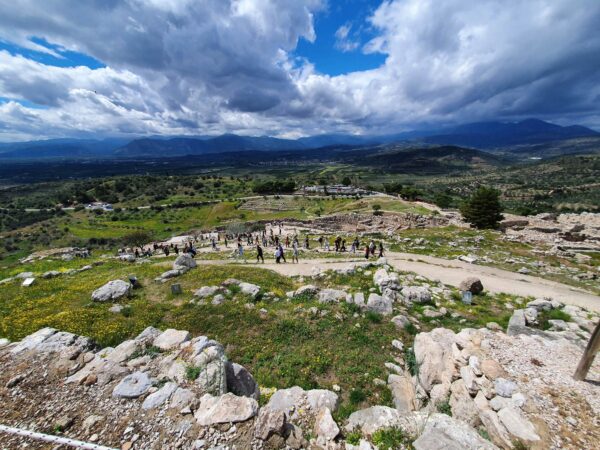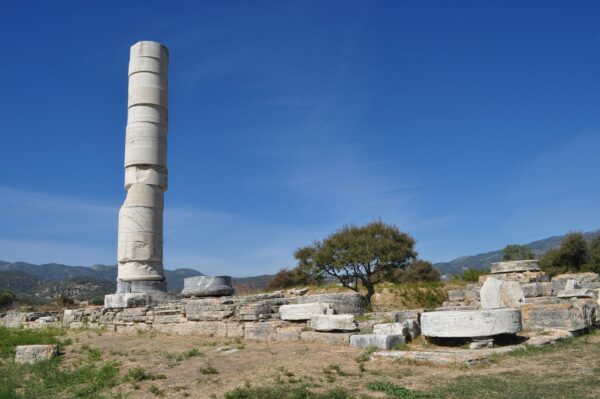Greece is home to 19 UNESCO World Heritage Sites, including the UNESCO world heritage site Greece, each with a story to tell. In this guide, we’ll explore ancient temples, historic cities, and unique architectural feats that illustrate Greece’s rich cultural heritage. Discover what makes each site special and why they belong on the global stage.
Key Takeaways
- The Acropolis of Athens, home to masterpieces like the Parthenon and the Erechtheum, exemplifies the artistic and architectural achievements of classical Greece and was inscribed as a UNESCO World Heritage Site in 1987.
- Delphi, once regarded as the ‘navel of the world’ in Greek mythology, served as a major religious sanctuary, with its oracle playing a pivotal role in ancient decision-making, and is recognized for its historical and cultural significance as a UNESCO World Heritage Site.
- The Sanctuary of Asklepios at Epidaurus, famed for its Theatre with unparalleled acoustics, showcases advancements in ancient medical practices and was listed as a UNESCO World Heritage Site in 1988 for its significant contributions to history and architecture.
Plan Your Dream Trip to Greece!
Embark on an unforgettable journey to explore Greece's world-renowned UNESCO World Heritage Sites. From the majestic Acropolis of Athens to the serene sanctuaries of Delphi, each site offers a unique glimpse into ancient civilizations and their lasting legacies. Don't miss the chance to witness these cultural treasures firsthand. Book your flight to Greece now and immerse yourself in the rich history, stunning architecture, and breathtaking landscapes that await you!
The Acropolis of Athens
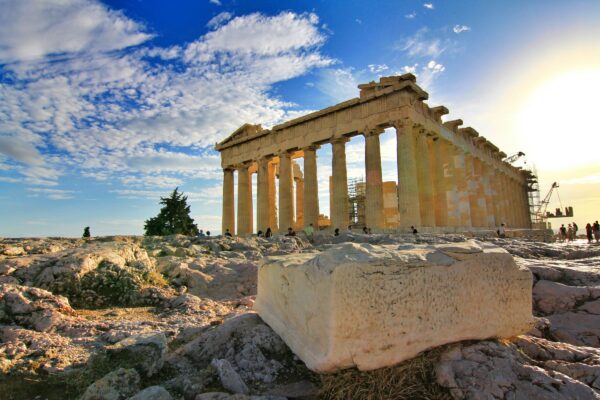
Perched high above the city of Athens, the Acropolis stands as a testament to the glory of ancient Greece. This citadel, initially fortified by the Mycenaeans in the Bronze Age, saw significant development during the 5th century BCE under the leadership of Pericles. The Acropolis, fully constructed in the 5th century BCE, is a symbol of the artistic and architectural achievements of classical Greece.
Among its notable structures, the Acropolis in Athens is home to several architectural masterpieces, including:
- The Parthenon, dedicated to the goddess Athena, stands out as a crowning achievement of ancient Greek architecture.
- The Erechtheum, with its famous Porch of the Caryatids, showcases the intricate beauty of Ionic architecture.
- The Temple of Athena Nike, the first fully Ionic temple on the Acropolis, is a testament to the skill and innovation of ancient Greek architects.
These structures, built with meticulous attention to detail, reflect the grandeur and sophistication of the ancient Greek world.
The Acropolis of Athens, acclaimed for its exceptional universal value, was inscribed as a UNESCO World Heritage Site in 1987. This site, a beacon of human creative genius and a symbol of the cultural and historical heritage of Greece, continues to inspire awe and reverence in visitors from around the world.
Archaeological Site of Delphi
Nestled on the slopes of Mount Parnassus, the Archaeological Site of Delphi was once considered the ‘navel of the world’ in ancient Greek mythology. According to legend, it was here that Apollo, the god of prophecy, slew the serpent Python, marking the transition from chthonian to celestial cults. Delphi’s significance in the ancient world is unparalleled, serving as a major religious sanctuary and a symbol of Hellenic unity.
The sanctuary of Apollo at Delphi, known for its oracle, attracted pilgrims from all over the ancient world. Kings and city-states offered treasures and built monumental structures like temples and treasuries, reflecting the site’s religious and political importance. The oracle’s prophecies played a crucial role in decision-making, influencing events far beyond the borders of Greece.
Delphi’s influence extended beyond its geographical confines, with its artistic and cultural impact felt across the ancient world. The Pythian Games, held every four years, were a testament to the site’s significance, bringing together people in a celebration of unity and competition. Delphi, celebrated for its cultural and historical significance, is enshrined as a UNESCO World Heritage Site, providing insight into ancient Greece’s spiritual core.
Sanctuary of Asklepios at Epidaurus
In the peaceful countryside of central Greece lies the Sanctuary of Asklepios at Epidaurus, a site dedicated to the god of medicine. This sanctuary, which evolved from a ceremonial healing site to a principal therapeutic center, showcases the transition from divine healing to the science of medicine. By the 6th century BCE, Epidaurus had become the foremost medical center of the ancient world.
The sanctuary is home to several remarkable structures, including:
- The Theatre of Epidaurus, renowned for its perfect architectural proportions and exemplary acoustics
- The Temples of Artemis and Asklepios
- The Tholos
- The Enkoimeterion
Each of these buildings contributes to the site’s historical and architectural significance.
The Sanctuary of Asklepios at Epidaurus, esteemed for its remarkable universal value, joined the UNESCO World Heritage Sites list in 1988. This site, a testament to the advancements in ancient medical practices and architectural ingenuity, continues to inspire and educate visitors about the rich heritage of Greece.
Meteora Monasteries
High atop nearly inaccessible sandstone peaks in Thessaly, the Meteora Monasteries offer a breathtaking blend of natural beauty and spiritual tranquility. Monks began settling on these peaks as early as the 11th century, seeking solitude and spiritual elevation. By the 15th century, 24 monasteries had been established, embodying a revival of the eremitic ideal.
The frescoes within these monasteries, particularly those from the 16th century, mark a significant phase in the development of post-Byzantine painting. These artworks, with their vivid colors and intricate details, reflect the artistic advancements and spiritual fervor of the time.
The Meteora Monasteries, distinguished for their extraordinary universal value, were incorporated into the UNESCO World Heritage Sites list in 1988. These monastic complexes, perched atop towering rocks, continue to be a source of inspiration and awe, offering a unique perspective on the confluence of nature, art, and spirituality.
Medieval City of Rhodes
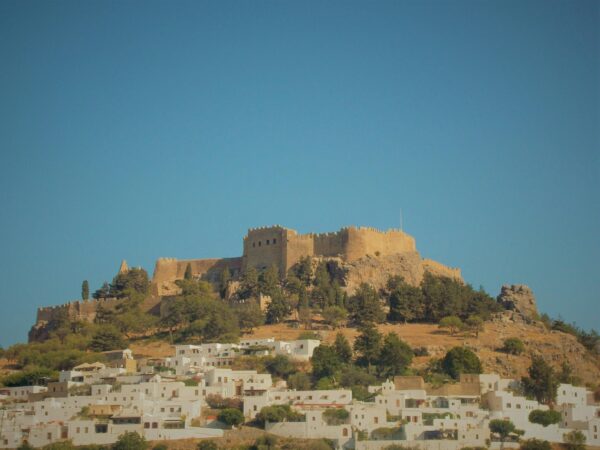
The Medieval City of Rhodes, constructed by the Knights of Saint John of Jerusalem, stands as a testament to the architectural and historical significance of the ancient city. Established in 1309, the Knights built around the ancient Byzantine city, creating a fortified enclave that served both military and administrative purposes.
The northern quarter, known as ‘Chateau,’ housed administrative buildings, the hospital, cathedral, and residences of the Knights and Grand Master. In contrast, the southern quarter, ‘Ville,’ contained houses of the laity, the street market, synagogues, and churches. Notable structures include the Palace of the Grand Masters, the Great Hospital, and the Street of the Knights, each reflecting the Gothic and Renaissance architectural styles with Byzantine and Ottoman influences,.
The Medieval City of Rhodes, appreciated for its architectural and historical importance, was designated as a UNESCO World Heritage Site in 1988. This site, with its well-preserved medieval architecture, continues to be a living testament to the rich history and cultural heritage of Rhodes.
Old Town of Corfu
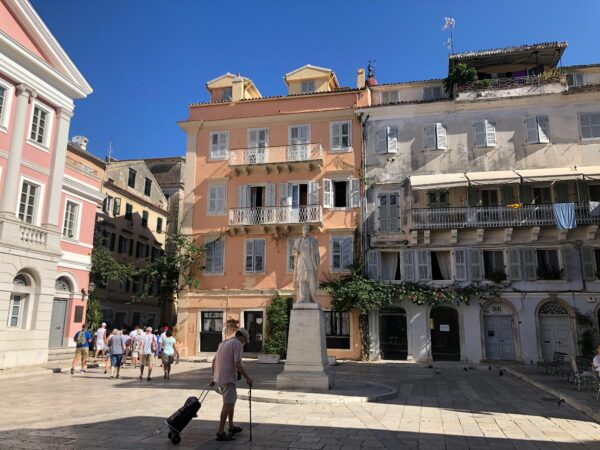
Located on the island of Corfu, the Old Town of Corfu is a gem of the Ionian Islands, strategically positioned at the entrance to the Adriatic Sea. The town’s three forts, designed by renowned Venetian engineers in the 8th century, played a crucial role in defending Venice’s maritime trading interests against the Ottoman Empire. These forts, repaired and rebuilt over centuries, showcase the town’s rich historical tapestry.
The housing stock in the historic centre, also known as the Old Town, is predominantly neoclassical, dating back to the Venetian period and the 19th century. This architectural style, characterized by its integrity and authenticity, reflects the town’s historical significance and the influence of various European powers over the centuries.
The Old Town of Corfu, noted for its exceptional universal value, was included in the UNESCO World Heritage List in 2007. This site, with its blend of Venetian, British, and French architectural influences, continues to captivate visitors with its charm and historical depth.
Archaeological Site of Olympia
The Archaeological Site of Olympia, nestled in the verdant valley of the Alpheios River, is the birthplace of the ancient Olympic Games. These games, first held in 776 BC, were dedicated to Zeus and celebrated every four years, bringing together athletes from across the Greek world. Olympia’s historical and cultural significance is unparalleled, making it a cornerstone of ancient Greek civilization.
At Olympia, key structures include:
- The Temple of Zeus
- The Temple of Hera
- The ancient stadium
- The Philippeion
The Altis, a sacred enclosure within Olympia, houses these temples, cult buildings, and treasuries, reflecting the site’s religious and political importance. The sanctuary of Zeus, at the core of Olympia, symbolizes the unity and competitive spirit of the ancient Olympic Games.
Olympia, renowned for its outstanding universal value, was added to the roster of UNESCO World Heritage Sites in 1989. This site, a testament to the origins of the Olympic Games and the cultural heritage of ancient Greece, continues to inspire and educate visitors worldwide.
Delos Island
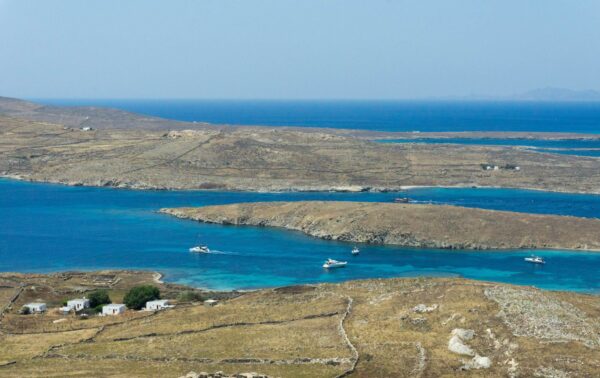
Delos Island, a sacred island in Greek mythology, holds an unparalleled place in Hellenic history as the birthplace of the twin deities Artemis and Apollo. This mythological significance transformed Delos into a major cult center, revered between 900 BC and 100 AD for the worship of gods like Dionysus and Leto. The island’s spiritual importance made it a pilgrimage site for ancient Greeks, who sought divine favor and guidance.
The island’s historical and architectural significance is evident in landmarks such as the Temple of the Delians, dedicated to Apollo, and the Terrace of the Lions, which features marble guardian lions dedicated by the people of Naxos around 600 BC. The first purification of Delos in the sixth century BC, where all graves within sight of the temple were relocated, underscores its sacred status.
Delos Island, recognized for its exceptional universal value, was included in the Greek UNESCO World Heritage Sites list in 1990. This recognition highlights the island’s cultural and historical significance. This site, with its blend of mythological, religious, and historical elements, continues to captivate and inspire visitors, offering a unique glimpse into ancient Greek spirituality and culture.
Mount Athos

Mount Athos, often referred to as the “Holy Mountain,” has been a significant Orthodox spiritual center since Byzantine times. Home to 20 monasteries and over 1,400 monks, this monastic state is known for its spiritual and artistic heritage. The first monastery, the Great Lavra, was founded in 963, marking the beginning of a long tradition of monastic life.
Life on Mount Athos is governed by strict rules to preserve the monastic celibate lifestyle, including a ban on women and female domestic animals. The monasteries house rich collections of artifacts, rare books, ancient documents, and artworks of significant historical value. The monastic community has seen a revival since the 1970s, attracting younger, well-educated monks from various countries.
Due to its remarkable universal value, Mount Athos was included in UNESCO’s World Heritage Sites list in 1988. This recognition highlights its cultural and natural significance. This autonomous monastic state continues to be a beacon of Orthodox spirituality and a repository of priceless cultural and religious artifacts, offering a unique spiritual experience to its visitors.
Byzantine Monuments of Thessaloniki
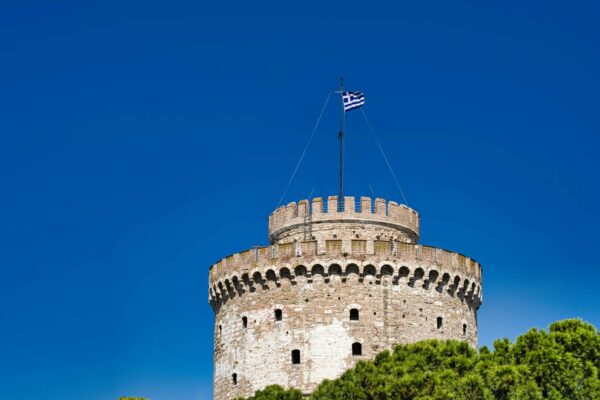
Thessaloniki, a city with deep historical roots, played a crucial role in spreading Christianity in the region. The city’s Paleochristian and Byzantine monuments reflect its rich spiritual and architectural heritage. These include:
- The Church of Saint Demetrius
- The Church of Panagia Halkeon
- The Church of Saint Nicolas Orfanos
- The Rotonda of Saint George
The Church of Saint Demetrius, dedicated to the patron saint of Thessaloniki, stands out with its collection of six mosaic panels dating back to the period between its latest reconstruction and the Byzantine Iconoclasm,. The crypt beneath the church is believed to be the site where Saint Demetrius and other early Christians were martyred. Despite the devastation of the Great Thessaloniki Fire of 1917, the church was meticulously restored over several decades.
The Byzantine Monuments of Thessaloniki, celebrated for their exceptional universal value, were inscribed on the UNESCO World Heritage Sites list, highlighting the city’s key role in the annals of Byzantine art and Christian history.
Archaeological Sites of Mycenae and Tiryns
The archaeological sites of Mycenae and Tiryns offer a window into the Mycenaean civilization, which flourished between 1600 and 1100 BC and profoundly influenced classical Greek culture. Mycenae, known as the kingdom of the mythical figure Agamemnon, features iconic landmarks such as the Lion’s Gate and the Treasury of Atreus. Tiryns, situated on a low hill near the Argolic Gulf, is renowned for its massive defensive walls, known as cyclopean walls, due to the enormous stones used in their construction.
These sites are deeply connected to the stories and myths depicted in Homer’s Iliad and Odyssey, reflecting their cultural and historical significance. The architectural features, including corbelled tholos tombs and massive fortification walls, highlight the engineering prowess of the Mycenaeans.
The archaeological sites of Mycenae and Tiryns, acclaimed for their extraordinary universal value, were inscribed on the UNESCO World Heritage Sites list, providing a unique insight into early Greek civilization and its enduring influence on classical urban design and architecture.
Archaeological Site of Aigai (Vergina)
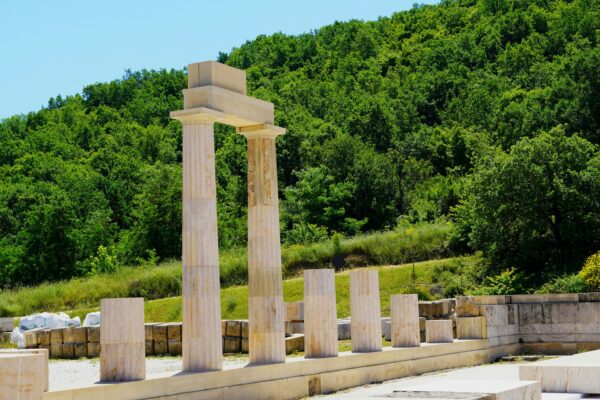
Aigai, the first capital of the Kingdom of Macedon, is a site of monumental historical significance. This ancient city, home to the royal dynasty of the Temenids, including Philip II and Alexander the Great, features a monumental palace and a royal necropolis with over 500 tumuli dating from the 11th to the 2nd century BC.
The monumental palace at Aigai, built around 340 BC, is one of the most impressive buildings of classical Greece, showcasing painted stuccoes and mosaic decorations. The discovery of Philip II’s tomb in 1977-78, along with rich grave goods crafted by renowned ancient Greek artists, caused a worldwide sensation and provided valuable insights into the culture, history, and society of the ancient Macedonians.
Aigai, protected under Greek law and acclaimed for its exceptional universal value, was inscribed on the UNESCO World Heritage Sites list, offering a captivating insight into the early history of Macedon and Alexander the Great’s legacy.
Temple of Apollo Epicurius at Bassae
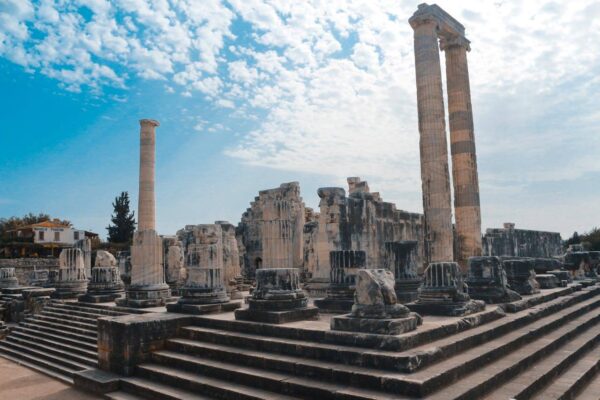
Perched atop the Arcadian mountains, the Temple of Apollo Epicurius at Bassae is a marvel of ancient Greek architecture. Built in the 5th century BC, this temple is notable for being the earliest monument to incorporate all three ancient Greek architectural orders – Doric, Ionic, and Corinthian,. The capital of the central column of the temple is the most ancient conserved Corinthian capital, adding to its architectural significance.
Dedicated by the Phigaleians to Apollo Epicurius, whom they believed protected them from plague and invasion, the temple stands as a testament to the religious and cultural practices of ancient Greece. The rural setting of the temple adds to its serene and majestic aura, attracting visitors who seek to experience its historical and architectural grandeur.
The Temple of Apollo Epicurius at Bassae, celebrated for its exceptional universal value, was the first Greek site inscribed on the World Heritage List in 1986, underscoring its importance in ancient Greek architectural history.
Pythagoreion and Heraion of Samos
The Pythagoreion and Heraion of Samos are significant UNESCO World Heritage Sites that showcase the rich archaeological heritage of the island. The Pythagoreion, named after the famous mathematician Pythagoras, features the Eupalinus’ tunnel, a 1036 meter long aqueduct from the 6th century BC, exemplifying ancient engineering prowess. The ancient fortified port in the Pythagoreion highlights the area’s importance during Classical and Roman times.
The Heraion of Samos is home to the Great Temple of Hera, a monumental structure started during the reign of Polycrates around 535-522 BC. This temple, with its peristyle of 155 columns, significantly influenced classical architecture with its stylistic and structural innovations. The sanctuary of the goddess Hera, originally constructed in the 8th century, reflects the island’s long-standing religious significance.
The Pythagoreion and Heraion of Samos, lauded for their extraordinary universal value, were incorporated into the UNESCO World Heritage Sites list in 1992, demonstrating the island’s abundant historical and cultural legacy.
Monasteries of Daphni, Hosios Loukas, and Nea Moni
The Monasteries of Daphni, Hosios Loukas, and Nea Moni are remarkable examples of Byzantine monastic architecture and art. These monasteries showcase the architectural ingenuity of the Byzantine era, with features such as:
- Built on a cross-in-square plan with a large dome supported by squinches
- Nea Moni exemplifies a simple octagonal church
- Hosios Loukas and Daphni feature a central octagonal space surrounded by bays forming a square
The artistic significance of these monasteries, which were built during the Byzantine Empire, is highlighted by their marble works and mosaics on a gold background, characteristic of Byzantine art’s second golden age. The mosaics, considered unique artistic achievements, have been preserved in their authentic form, offering a glimpse into the rich artistic heritage of the Byzantine period.
The Monasteries of Daphni, Hosios Loukas, and Nea Moni, acclaimed for their exceptional universal value, were included in the UNESCO World Heritage Sites list in 1990, reflecting their significance in Byzantine architectural and artistic history.
Archaeological Site of Philippi
The Archaeological Site of Philippi, established by Thassian settlers named Crenides in 360-359 BC, is a testament to the city’s historical and cultural significance. Located at the foot of an acropolis in the city of Macedonia and Thrace, Philippi played a crucial role in the Roman Empire after the Battle of Philippi in 42 BC,.
Key attractions at Philippi include:
- Fortified walls
- The Acropolis with a Byzantine tower
- The Roman Agora
- The Octagon, a large temple complex dedicated to Apostle Paul, highlighting the city’s significance in early Christian history
- The Roman Cistern, noted as the place where Apostle Paul was imprisoned
These attractions add to the site’s historical depth, making it one of the must-visit cultural sites.
Philippi, famed for its remarkable universal value, was inscribed on the UNESCO World Heritage Sites list, providing a unique insight into the city’s rich Christian and Roman heritage.
Monastery of Saint John and Cave of Apocalypse in Patmos
The Monastery of Saint John and the Cave of Apocalypse in Patmos are significant religious and historical sites. Founded in 1088 by Hosios Christodoulos Latrinos under Emperor Alexios I Komnenos’ policy to colonize the islands, the monastery honors St. John and serves as a center of Greek Orthodox learning and pilgrimage.
The Cave of Apocalypse, where Saint John is believed to have written the Book of Revelation and his Gospel, adds to the site’s spiritual significance. The monastic community of Patmos preserves old traditions and rituals, such as the Byzantine ritual of Niptir, contributing to the site’s authenticity and spiritual atmosphere.
The Monastery of Saint John and the Cave of Apocalypse in Patmos, appreciated for their exceptional universal value, were incorporated into the UNESCO World Heritage Sites list, underscoring their significance in Greek Orthodox spirituality and Christian history.
Zagori Cultural Landscape
The Zagori Cultural Landscape, a remote region in the Pindus mountains in northwest Greece, is renowned for:
- Its natural beauty
- Historically significant stone villages
- Architecture characterized by small stone villages adapted to the mountain topography, showcasing the survival and mutual influence of Byzantine and Ottoman architecture
- Stone-arched bridges, stone cobbled paths, and stone staircases that link the villages, reflecting the region’s unique cultural heritage.
Cultural aspects such as music, festivals, and traditions also played a significant role in Zagori’s UNESCO nomination. The region’s natural and cultural heritage make it a distinctive and valuable part of Greece’s historical landscape. Zagori, the first region in Greece recognized by UNESCO for its modern-era cultural heritage, is lauded for its exceptional universal value, providing a unique view of the region’s cultural and natural relevance.
Archaeological Site of Mystras
Mystras, often referred to as the ‘wonder of the Morea', is an archaeological site of immense historical significance. Built as an amphitheatre around a fortress erected in 1249 by William of Villehardouin, the prince of Achaia, Mystras stands as a testament to the rich and tumultuous history of the region.
The site saw a series of occupations, having been reconquered by the Byzantines, and later occupied by the Turks and the Venetians. Each of these periods left its mark on the city, contributing to its architectural and cultural legacy. Mystras was ultimately abandoned in 1832, but the breathtaking medieval ruins remain, offering a glimpse into the past amidst a stunning natural landscape.
Visitors to Mystras can explore the remnants of its once-glorious structures, including churches, palaces, and monasteries, all set against the backdrop of the lush, rolling hills of the Peloponnese. The site is a poignant reminder of the city’s historical importance and a fascinating destination for those interested in Byzantine and medieval history.
Mystras, recognized for its exceptional universal value, is inscribed on the UNESCO World Heritage Sites list. This designation underscores the site's significance as a cultural and historical treasure, preserving the legacy of a city that once played a pivotal role in the history of the Morea.
Summary
Exploring Greece’s UNESCO World Heritage Sites offers a profound journey through the annals of history, revealing the rich tapestry of ancient civilizations and their lasting legacies. From the majestic Acropolis of Athens to the serene sanctuaries of Delphi, each site tells a unique story of human achievement, creativity, and spirituality. These sites are not merely remnants of the past; they are living testimonies to the enduring spirit of Greece and its contributions to world heritage.
As we conclude this journey, we are reminded of the importance of preserving these cultural treasures for future generations. Each site, with its unique blend of history, architecture, and mythology, offers invaluable insights into the ancient world and continues to inspire awe and reverence. Let us cherish and protect these heritage sites, ensuring that their stories continue to be told and their beauty admired for centuries to come.
Frequently Asked Questions
The Acropolis of Athens is a UNESCO World Heritage Site because it represents the ancient Greek civilization and displays remarkable architectural masterpieces such as the Parthenon and the Erechtheum.
Delphi is considered the ‘navel of the world' in ancient Greek mythology due to the belief that it was the center of the earth, marked by the omphalos stone. This designation is rooted in ancient Greek mythology.
The Theatre of Epidaurus is significant due to its perfect architectural proportions and exemplary acoustics, which make it a renowned structure in the history of ancient Greek architecture.
Mount Athos is restricted to men only in order to preserve the monastic celibate lifestyle, which has been a tradition since Byzantine times. This tradition is important to the community on Mount Athos.
The key features of the archaeological site of Olympia include the Temple of Zeus, the Temple of Hera, the ancient stadium, and the Philippeion, showcasing its historical importance as the birthplace of the ancient Olympic Games.


